Start-ups Solving Internet of Things Growth Constraints | Market Insights™
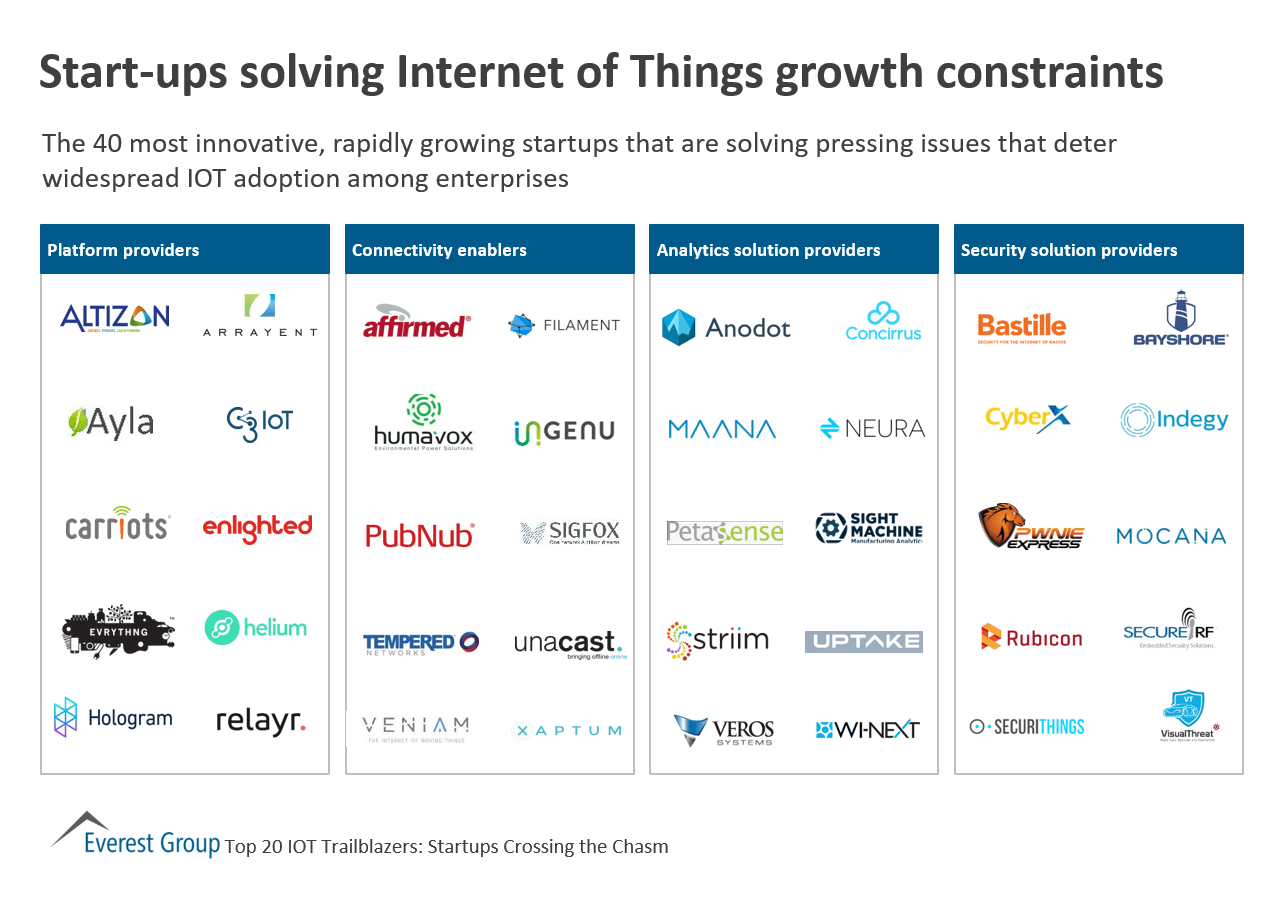
The 40 most innovative, rapidly growing startups that are solving pressing issues that deter widespread IOT adoption among enterprises

The 40 most innovative, rapidly growing startups that are solving pressing issues that deter widespread IOT adoption among enterprises
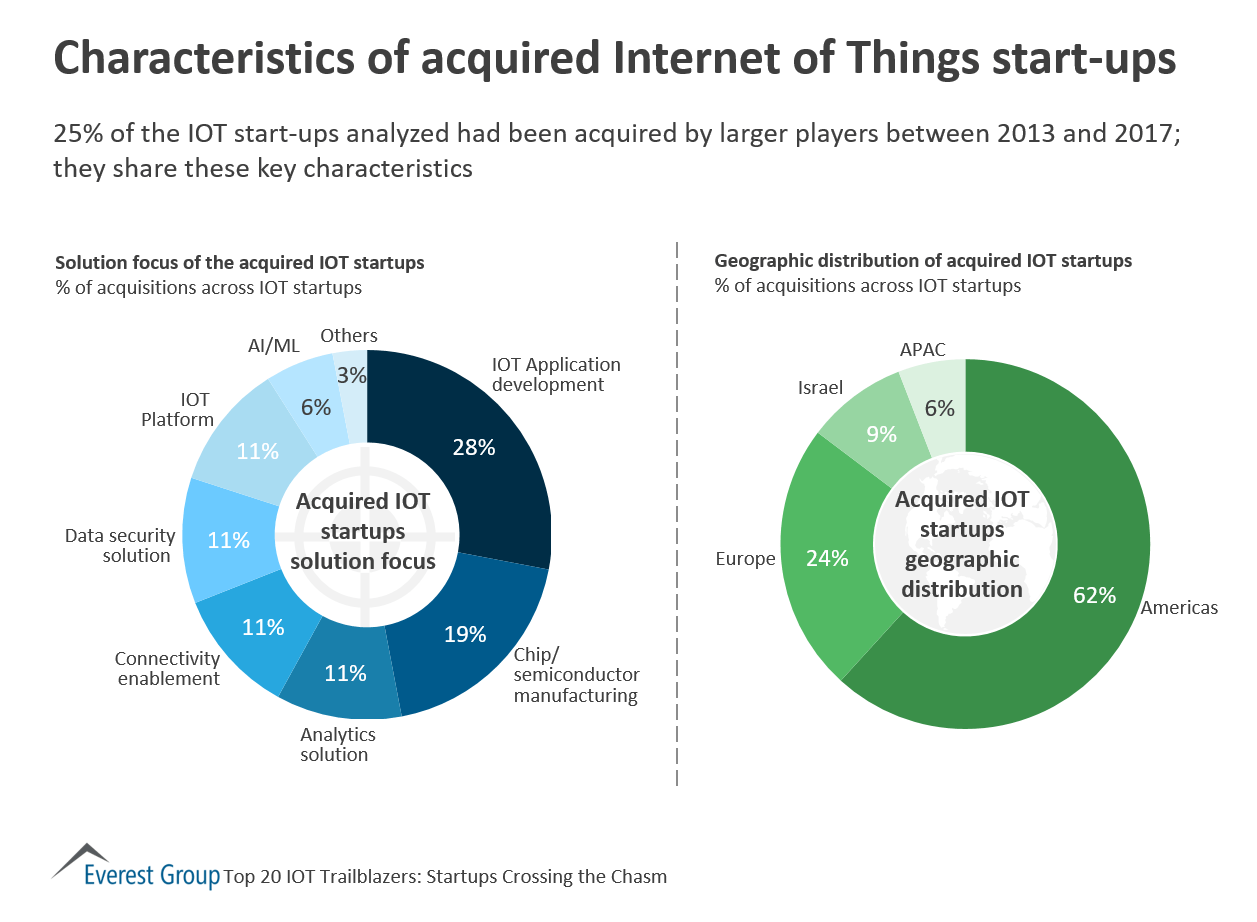
25% of the IOT start-ups analyzed had been acquired by larger players between 2013 and 2017; they share these key characteristics
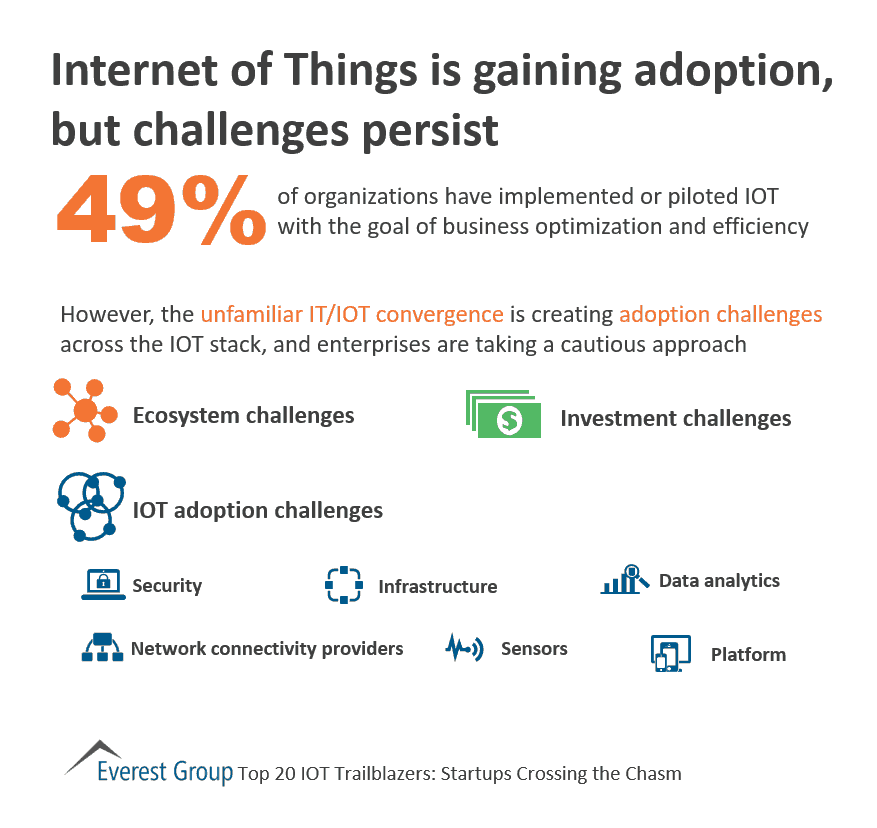
49% of organizations have implemented or piloted IOT with the goal of business optimization and efficiency; however, the unfamiliar IT/IOT convergence is creating adoption challenges across the IOT stack, and enterprises are taking a cautious approach
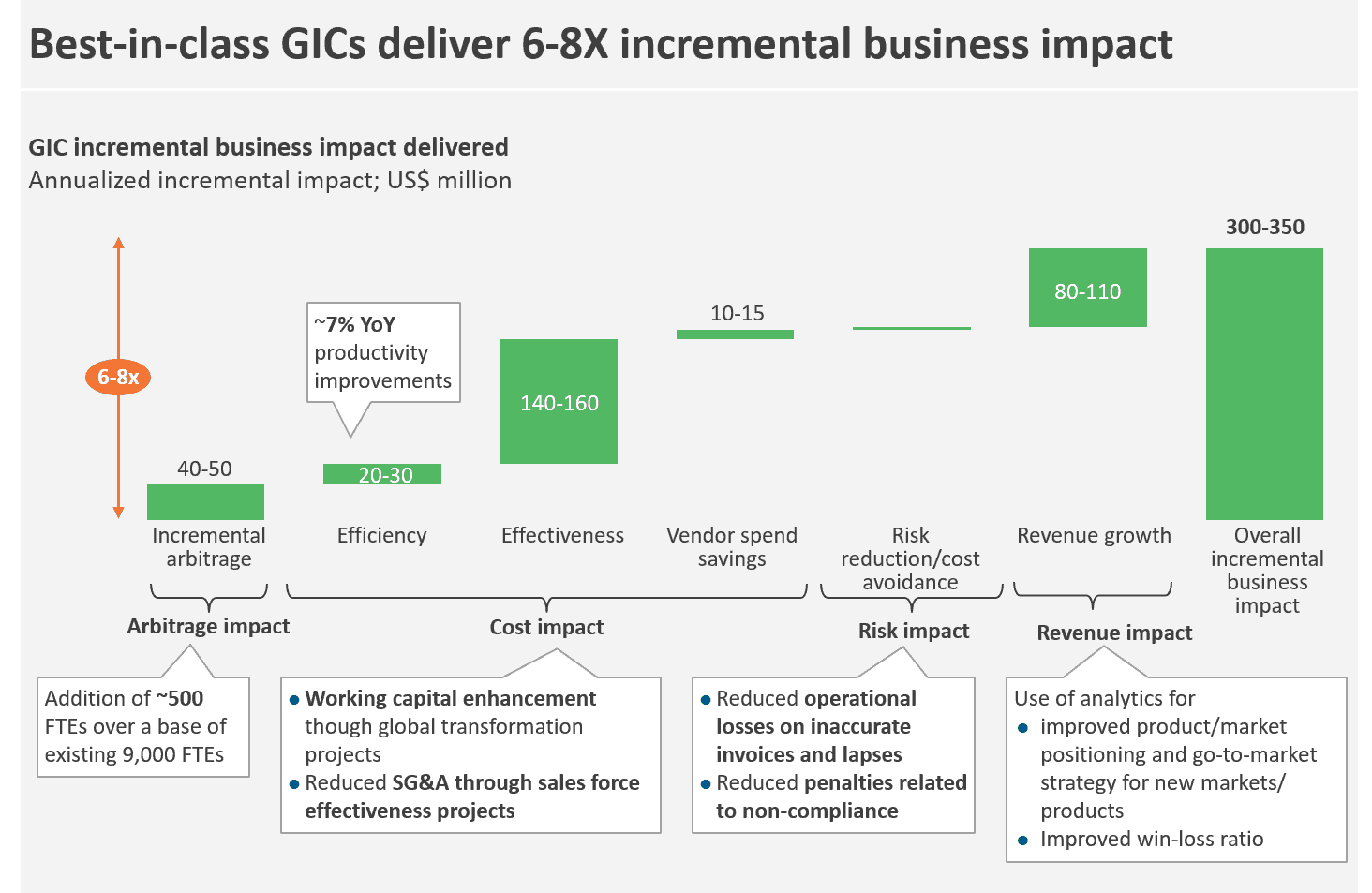
Best-in-class GICs deliver 6-8X incremental business impact through arbitrage, cost improvement, risk reduction, and revenue increase.
Recently, an official from the Trump administration accused Indian IT providers of abusing the H-1B visa process by “flooding” the lottery system with applications, giving them an unfair lottery draw advantage. The statement again spotlighted the issue of importing foreign IT services workers to the U.S., thereby limiting job opportunities for domestic candidates. It also underscored the huge extent of outsourcing being done by U.S. corporations, especially to offshore-heritage providers. What it didn’t discuss was other types of companies’ usage of the H-1B program to import skilled talent into the country.
Everest Group conducted a quick analysis on the Labor Condition Applications (LCAs) employers filed to obtain H-1B visas in the last few years. We classified the employers into several categories:
Our findings?
(For the uninitiated, a certified LCA (ETA Form 9035), is a prerequisite to H-1B approval. The LCA must be certified by the Department of Labor (DOL) before the H-1B petition (Form I-129) is submitted to USCIS. The LCA contains basic wage and location information about the proposed H1B employment. Please note that a certified LCA does not guarantee H-1B visa approval, however, certified position trends are good indicators of H-1B visa usage. Also, note that the data below includes positions certified for new H-1B visa applications as well as renewal and transfer of H-1B visa.)
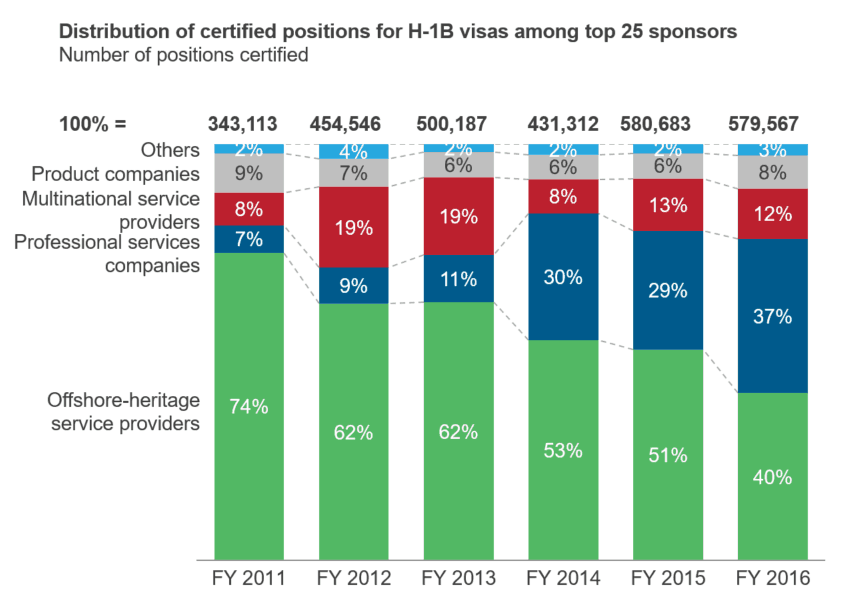
One of the Trump administration’s suggested reforms is to increase the minimum wage for H-1B visas from US$60,000 to US$130,000. But as this minimum wage recommendation is applicable to companies that are “H-1B dependent” – and most offshore-heritage providers fall into this category – the required increase in minimum wage, whatever it ultimately is, will likely affect offshore-heritage providers more than any other type of organization.
At the same time professional services firms have quietly increased their leverage of the visa-led model, offshore-heritage providers have been the unfortunate recipients of far greater scrutiny and negative limelight. In order to successfully compete, offshore-heritage providers have no choice other than to prepare now for the impact of visa policy changes. As the old saying goes, “better safe than sorry.”
Much has been written and said about the Bimodal IT model Gartner introduced in 2014 – with forceful arguments for and against. Not at all intending to bash that model, it’s safe to say that the digital explosion over the last three years demands that enterprises’ technology strategies be much more nuanced and dynamic.
Let me explain with the help of the following chart. I call it the Maintain-Optimize-Reimagine-Explore – the MORE – model.
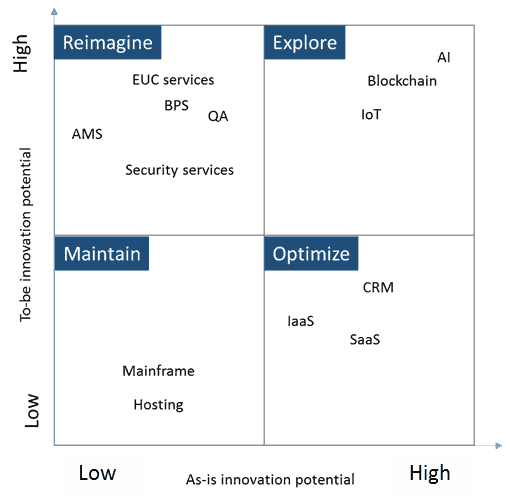
I’ve tried to plot (intuitively) a bunch of technology and service themes on their current and future innovation potential.
It’s interesting to note that many of these reimagination exercises are based on three common foundational principles:
Over the next several months, Everest Group is going to publish viewpoints on each of these topics and more. But we’d love to hear any comments and questions you have right now. Please share with us and our readers!
Vice President of Research Salil Dani will be a key speaker at the 2017 Nexus nearshore conference at the Google Quad Campus in Mountain View, California.
Salil will speak on “The State of Nearshore: Key Finding and Analysis.” Speaking session summary: Last year saw the expansion of digital services across Latin America, but will this trend continue? Many leaders were bullish on Argentina, Costa Rica, and Guadalajara Mexico, but what other regions are on the path to providing top notch talent? This presentation examines the relative cost of operations, the risk profiles and preparedness for digital of various regions across Latin America and who might be leading the way in offering cloud, mobile, big data, and IOT.
When
May 23-24, 2017
Where
Google Quad Campus
N Whisman Road
Mountain View, California
Speaker
Salil Dani, Research Vice President, Everest Group
Learn more and register
Marc Andreessen’s famous quote about software eating the world popped up often in the last couple of years. However, the fashionable and fickle technology industry is now relying on artificial intelligence to drive similar interest. Most people following AI would agree that there is a tremendous value society can derive from the technology. AI will impact most of our lives in more ways than we can think of today. In fact, it often is hard to argue against the value AI can potentially create for society. Indeed, with the increasing noise and real development around AI, there are murmurs that AI may replace software as the default engagement model.
Think about it. When we use our phone or Amazon Alexa to do a voice search, we simply speak, hardly using the app or software in the traditional sense. A chatbot can become a single interface for multiple software programs that allow us to pay our electric, phone, and credit card bills.
Therefore, artificial intelligence replacing software as the next technology shift is quite possible. However, can we rely on AI? Or, more precisely, can we always rely upon it? A particularly concerning issue is that of bias. Indeed, there have been multiple debates around the bias an AI system can introduce.
It’s true that humans have biases. As a result, we’ve established checks and balances, such as superiors and laws, to discover and mitigate them. But how would an AI system determine if the answer it is providing is neutral and bereft of bias? It can’t, and because of their extreme complexity, it’s almost impossible to explain why and how an AI system arrived at a particular decision or conclusion. For example, a couple of years ago Google’s algorithms classified people of a certain demography in a derogatory manner.
It is certainly possible that the people who design AI systems may introduce their own biases into them. Worse, however, is that AI systems may over a period of time start developing their own biases. And even worse, they cannot even be questioned or “retaught” the correct way to arrive at a conclusion.
There have already been instances in which AI systems gave results for which they weren’t even designed. Now think about this in a business environment. For example, many enterprises will leverage an AI system to screen the resumes of potential candidates. How can the businesses be sure their system isn’t rejecting good candidates due to some machine bias?
A case of this type could be considered an acceptable, genuine mistake, and it could be argued that the system isn’t doing it deliberately. However, what happens if these mistakes eventually turn into unethicality? We can pardon mistakes but we shouldn’t do the same with unethical decisions. Taking it one step further, given that these systems ideally learn on their own, will their unethicality become manifold as the time progress?
How far-fetched it is that the AI systems become so habitually unethical that users become frustrated? What are the chances that humanity stops further developing AI systems when it realizes that it’s not possible to create AI systems without biases? While every technology brings a level of evil with the good, AI’s negative aspects could multiply very fast, and mostly without explanation. If these apprehensions scare developers away, society and business could lose AI’s tremendous potential positive improvements. That would be even more unfortunate.
As the adoption of AI systems increases, we will likely witness more cases of wrong or unethical behavior. This will fundamentally question and push regulators and developers to put boundaries around these systems. But therein is a paradox: developing systems that learn on their own, while putting boundaries around that learning – quite a contradiction. However, we must overcome these challenges to exploit the true potential of AI.
What do you think?
Any emerging technology goes through a hype stage. It takes a while to get the kinks out and for pilots and proofs of concepts to prove use cases and shift the curve to broad adoption. The power and disruption of blockchain is evident in the news almost daily, and people are beginning to understand how blockchain distributed ledger technology works. I’ve previously blogged about soaring investments in pilots and proofs of concepts (POCs) on its security and examples of use cases. Even so, there are several issues currently slowing adoption.
Blockchain adoption is currently crossing the chasm, and I believe the next two years will be critical for resolving issues now slowing broader adoption.

©2023 Everest Global, Inc. Privacy Notice Terms of Use Do Not Sell My Information
"*" indicates required fields